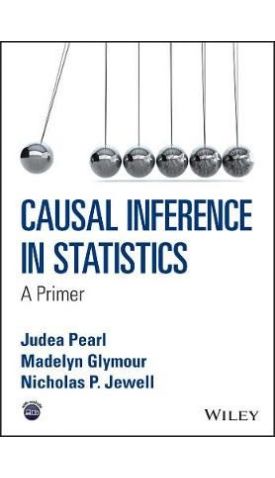אנו משתמשים ב-Cookies כדי לשפר את החוויה שלך. כדי לקיים ההנחיה החדשה של e-Privacy, עלינו לבקש את הסכמתך להגדיר את ה-Cookies. קבלת מידע נוסף.
182.00 ₪
Causal Inference in Statistics - A Primer 1
182.00 ₪
ISBN13
9781119186847
יצא לאור ב
Hoboken
עמודים
156
פורמט
Paperback / softback
תאריך יציאה לאור
4 במרץ 2016
Many of the concepts and terminology surrounding modern causal inference can be quite intimidating to the novice. Judea Pearl presents a book ideal for beginners in statistics, providing a comprehensive introduction to the field of causality.
Many of the concepts and terminology surrounding modern causal inference can be quite intimidating to the novice. Judea Pearl presents a book ideal for beginners in statistics, providing a comprehensive introduction to the field of causality. Examples from classical statistics are presented throughout to demonstrate the need for causality in resolving decision-making dilemmas posed by data. Causal methods are also compared to traditional statistical methods, whilst questions are provided at the end of each section to aid student learning.
| עמודים | 156 |
|---|---|
| פורמט | Paperback / softback |
| ISBN10 | 1119186846 |
| יצא לאור ב | Hoboken |
| תאריך יציאה לאור | 4 במרץ 2016 |
| תוכן עניינים | About the Authors ix Preface xi List of Figures xv About the Companion Website xix 1 Preliminaries: Statistical and Causal Models 1 1.1 Why Study Causation 1 1.2 Simpson s Paradox 1 1.3 Probability and Statistics 7 1.3.1 Variables 7 1.3.2 Events 8 1.3.3 Conditional Probability 8 1.3.4 Independence 10 1.3.5 Probability Distributions 11 1.3.6 The Law of Total Probability 11 1.3.7 Using Bayes Rule 13 1.3.8 Expected Values 16 1.3.9 Variance and Covariance 17 1.3.10 Regression 20 1.3.11 Multiple Regression 22 1.4 Graphs 24 1.5 Structural Causal Models 26 1.5.1 Modeling Causal Assumptions 26 1.5.2 Product Decomposition 29 2 Graphical Models and Their Applications 35 2.1 Connecting Models to Data 35 2.2 Chains and Forks 35 2.3 Colliders 40 2.4 d-separation 45 2.5 Model Testing and Causal Search 48 3 The Effects of Interventions 53 3.1 Interventions 53 3.2 The Adjustment Formula 55 3.2.1 To Adjust or not to Adjust? 58 3.2.2 Multiple Interventions and the Truncated Product Rule 60 3.3 The Backdoor Criterion 61 3.4 The Front-Door Criterion 66 3.5 Conditional Interventions and Covariate-Specific Effects 70 3.6 Inverse Probability Weighing 72 3.7 Mediation 75 3.8 Causal Inference in Linear Systems 78 3.8.1 Structural versus Regression Coefficients 80 3.8.2 The Causal Interpretation of Structural Coefficients 81 3.8.3 Identifying Structural Coefficients and Causal Effect 83 3.8.4 Mediation in Linear Systems 87 4 Counterfactuals and Their Applications 89 4.1 Counterfactuals 89 4.2 Defining and Computing Counterfactuals 91 4.2.1 The Structural Interpretation of Counterfactuals 91 4.2.2 The Fundamental Law of Counterfactuals 93 4.2.3 From Population Data to Individual Behavior An Illustration 94 4.2.4 The Three Steps in Computing Counterfactuals 96 4.3 Nondeterministic Counterfactuals 98 4.3.1 Probabilities of Counterfactuals 98 4.3.2 The Graphical Representation of Counterfactuals 101 4.3.3 Counterfactuals in Experimental Settings 103 4.3.4 Counterfactuals in Linear Models 106 4.4 Practical Uses of Counterfactuals 107 4.4.1 Recruitment to a Program 107 4.4.2 Additive Interventions 109 4.4.3 Personal Decision Making 111 4.4.4 Sex Discrimination in Hiring 113 4.4.5 Mediation and Path-disabling Interventions 114 4.5 Mathematical Tool Kits for Attribution and Mediation 116 4.5.1 A Tool Kit for Attribution and Probabilities of Causation 116 4.5.2 A Tool Kit for Mediation 120 References 127 Index 133 |



Login and Registration Form